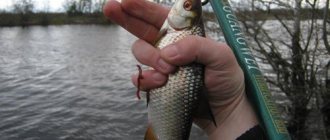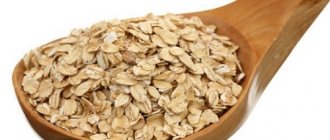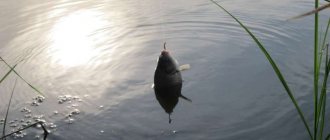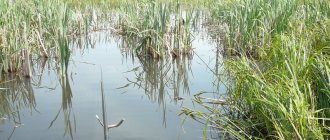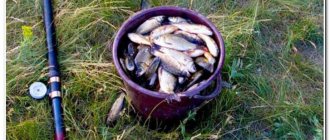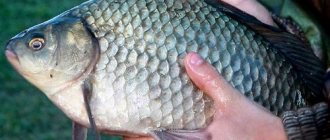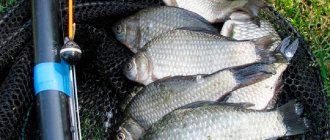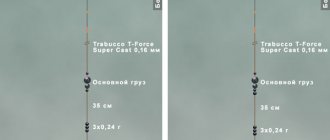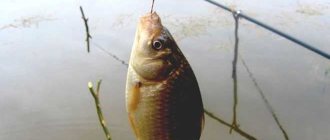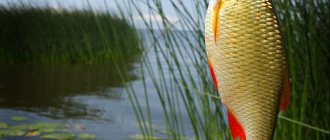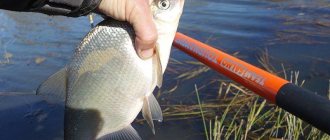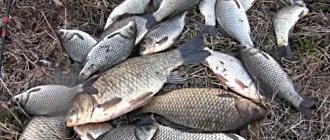In order for fishing for crucian carp in the spring with a float rod to be successful, you need not only to choose the right equipment, bait and bait, but also to take into account the peculiarities of seasonal changes. In some reservoirs, crucian carp become active in March, in others only in April, when constant warm weather sets in with daytime temperatures of 15 degrees and above. In this article we will look at when and how to catch crucian carp in the spring with a float rod, what equipment, lures and groundbait to use.
Fishing for crucian carp in spring
Catching crucian carp in the spring with a float rod during the silver run sometimes turns into pulling the fish one by one on coarse equipment. Such zhor in the spring is more often observed in the south, where the population of crucian carp (hybrid, dushman) is constantly growing - here the silverfish are warm and there is a lot of food.
In the middle zone, pre-spawning zhor is observed in May, with less intensity. There are not many crucian carp, the weight rarely exceeds 800 grams, and they are careful due to fishing pressure. Here in the spring you need to carefully select equipment and bait.
The activation of crucian carp in the spring depends on the water temperature - this happens when the reservoir in shallow places warms up to 7-10 degrees. Then the silverfish begins to emerge from deep waters to these warm spots. However, in rivers and reservoirs, especially in the south, large schools of the hybrid, still under the ice, accumulate in the mouths and lower reaches of tributaries in order to rise higher to spawn with the flood.
In early spring, if there is no ice on the bays since February, the crucian carp moves from the depths to shallow areas overgrown with reeds, pondweed, reeds and cattails - it is warmer and there is more food there. In such places, even in early spring, it is sometimes possible to fish - in the windows of these thickets. If the shallows are not biting yet, we look in the holes and behind the edge near the shallow waters, waiting for total warming. Read more about spring fishing for crucian carp.
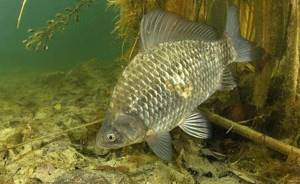
When do you catch crucian carp in the spring?
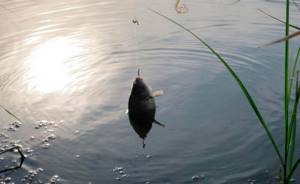
In the spring, there are periods of time when you can observe the best bite of crucian carp. During this period, crucian carp feed mainly in the morning and before sunset. During the daytime, when the water begins to warm up, he is busy sunbathing.
He prefers places that receive direct sunlight. At night, when the ambient temperature drops to zero and the water begins to cool, the crucian carp tries to go deeper. After sunset, as a rule, the biting stops, in contrast to the summer period, when after sunset crucian carp can be highly active, especially large ones.
The beginning of spring
You can start catching crucian carp with a float rod in the spring immediately after the ice breaks up - in the south, as well as in warm canals where the fish are active in winter. This is fishing in cold water, in deep areas beyond the edge, in holes.
- Little groundbait is used, only a finely dispersed inert mixture that will fall to the bottom and will not contain bright aromas and large particles. At most, you can add a little bloodworm to the mixture.
- On medium and large reservoirs, the parking areas for crucian carp in early spring can be tens of meters from the shore - you can’t always reach them even with a feeder or donka.
- If the parking lot is no further than 30-40 meters, you can reach it with a long-casting fishing rod, match equipment with a heavy float with a long antenna, visible from afar.
- In this case, the fishing rod should be loaded sensitively and delicately. Fishing - with bloodworms, small hooks and thin leashes. During fishing at this time there may be several bites of crucian carp, and you should not miss the chance.
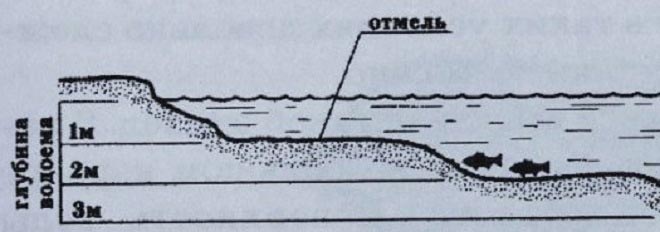
Possible points for crucian carp in early spring
March
In March, using a regular fishing rod in cold water, you can catch crucian carp in small rivers, if places are known, and also from a boat, also at certain points. It is unjustified to whip tackle and feed an unknown point in the spring. Like a lottery, the chance of winning is minimal. To catch crucian carp in early spring, you need to know where the school is - and it’s not a fact that there will be a bite.
Bites are possible in calm, sunny, warm weather if the pressure does not change for several days in a row. There is almost always still ice on ponds in March (except for warm southern reservoirs). If the spring is warm, and at the beginning of March everything has already melted (as sometimes happens in the Volgograd-Rostov latitude and further south), crucian carp can become more active at this time - then they are caught more actively (more on this later).
April
Early spring and subsequent warming in time is a relative concept. In different regions, spring changes occur earlier or later in different years. You should focus not on the calendar, but on the spring changes in nature. If it’s still cold in the spring, but you want crucian carp, we explore the coastal holes with thin rigs. When the water warms up to +10, we shift the focus of the search to bushes and thickets - shallow bays, areas near the shore, water areas with reeds with a depth of 0.5-1.5 meters
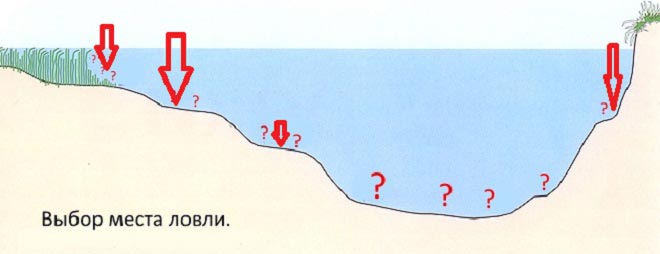
Overgrown areas near which there are holes with depths of up to 4 meters are promising in mid-spring. During the transition period, crucian carp can settle there, going out into shallow water during the day in good weather, where you need to look for it with a fishing rod.
There is no spawning ban yet, so you can wander through the reed shallows in waders (if there is little silt) or chase the silver in a boat. It is better not to make noise or splash with the oars; you need to move very carefully. From a boat, along the windows, you can work with a fly rod without a reel or with a jig and a side nod.
If the water is still clear, we use thin lines, 0.12-0.14 mm, even for a large hybrid, and small hooks with bloodworms, maggots or worms. Bait for crucian carp may not work at all at this time. We feed little, in places where there were bites. If we manage to get a bite, we take advantage of the moment. If the wind rises and mixes warm water with cold, the passive crucian carp’s bite will immediately stop.
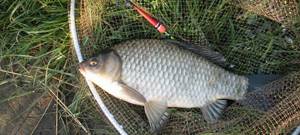
Spring bite of crucian carp
The main fishing for crucian carp in the spring with a float rod begins somewhere in mid-April (in a warm year and at the beginning of the month) in the southern regions and in early-mid May further north, when the water heats up to 12 degrees or more. Silver crucian carp begins to prepare for spawning. As the spring warms, migratory flocks rise up the tributaries, walk along the riverbed, entering the reeds to feed, or make their way straight along the bushes, if this type of relief continues for many kilometers.
Local crucian carp approach the banks, climb into the bushes and into the flooded meadows. In flooded rivers it can be found under flooded bushes or in the same shallow warmed creeks with reeds. Sometimes the bite begins when the water in the spring has already receded and it gets lighter - the places to search are the same. We check flooded areas, bays, oxbow lakes, and reed thickets.
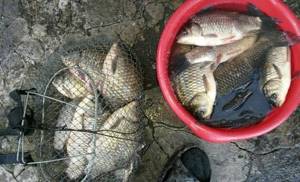
At this time, long-range donks are not needed - the golden time is gradually approaching for floaters for crucian carp. You can’t fish in the thickets with a donkey or a feeder, but you can come up with a fishing rod. In reservoirs with rising water, the best place in the spring is a strip of clean water between the shore and old bushes, which in the summer constitute coastal vegetation.
We fish in front of them, from the shore - it turns out, on the flooded coastal part. If the reeds are sparse, we throw them between them into windows or to the border with deep water. The whole range of possible gear for catching crucian carp in the spring with a fishing rod works here.
- The signal in the spring for the floater is the decline of the flood and clearing of the water, and not calendars that do not work. It is worth focusing on natural phenomena. Spawning of crucian carp begins when the water warms up to +16 and above in spring, in May-June. There is information that silver crucian carp is not caught for spawning, however, this is not the case.
- On the contrary, spawning, a couple of weeks before spawning and the same amount after, is the best time for fishing. This fish spawns for a long time. Usually its beginning coincides with the flowering of viburnum or bird cherry. Some individuals are getting ready, eating everything, others are “working” on their offspring, working in the thickets, while others have already spawned and are feeding heavily again.
- Only the specific female that is currently spawning does not bite. Males in the spring during spawning often happen to be snatched right with milk flowing from the belly. In the reeds, it is better not to be too thin with the equipment of the fishing rod and securely tie the hooks to the fishing line. We use fishing lines with a diameter of 0.18-0.25 and hooks NoNo14-10 for a bunch of worms, corn or maggots.
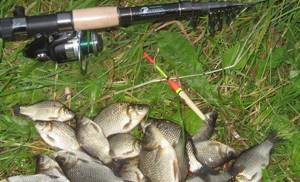
- As aquatic plants grow, plant baits and aromatics begin to work. The time has begun to experiment with the selection of groundbaits, baits, dips and attractants.
- Running crucian carp in the spring sometimes takes pearl barley or corn, as well as polystyrene foam, and in cold water, more out of curiosity, reacting to a bright contrasting color. With the warming in the spring, grains, mastyrki, mash and bread crumbs (preferably with honey, halva or cottage cheese) are already working.
- Among the aromas, it is worth paying attention to garlic and anise - these smells always work in the spring, however, we experiment carefully, do not add them to the bait, so as not to spoil them (unless it is known for certain that the silvery smells exactly like this here).
Article about catching crucian carp with a fishing rod in May
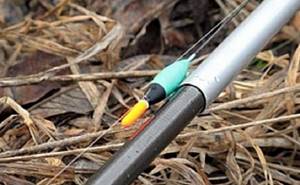
Golden crucian carp in spring
Silver crucian carp has filled water bodies, especially in the south, and the range of its golden counterpart is decreasing. But it can still be caught in closed reservoirs not connected to the main system, to the north. These are forest lakes, peat bogs, old ponds. Recommendations for fishing with a fishing rod in the spring are the same. The ichthyology of these fish is similar; silver crucian carp has a higher adaptive ability, which is the reason for viral spread.
Small shallow water bodies are the first to warm up - here you can try to catch the golden beauty with a fishing rod as early as April. Deeper waters begin to work later in the spring. Places for fishing for golden crucian carp in the spring are the same warm spots with thickets.
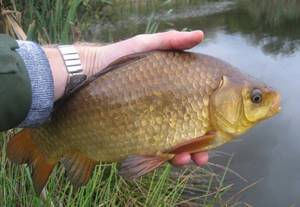
Fishing for crucian carp with fishing rods
For spring fishing for crucian carp with a float rod, various tackles are suitable - as long as it is possible to deliver the bait to the desired point. You can fish with ordinary fishing rods with a dead attachment to the tip (flying, plug-in gear) or a small inertial reel, as well as long-range fishing rods with reels - Bolognese (a regular float with an inertia-free reel), match fishing. The main thing is the right choice of place, feeding tactics, selection of attachments and bait.
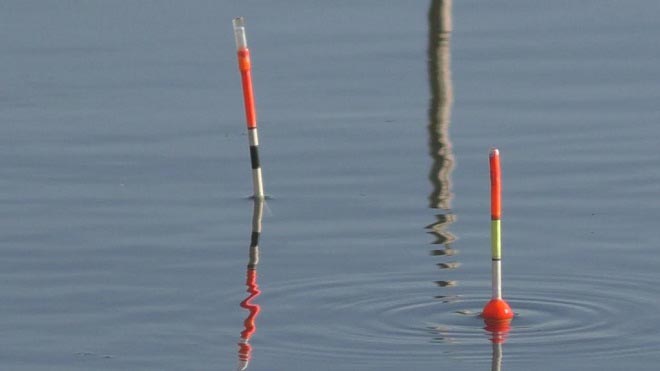
Tactical Approach
Crucian carp has never been famous for its consistency - either it has a frenzied glutton in bad weather, or it lacks a bite on good days on the baits that were working the day before. However, general trends in the tactics of fishing with a rod for spring crucian carp are present.
- Catching crucian carp in early spring with a float rod requires thin, delicate equipment, animal baits and a careful, careful approach to feeding. If we feed in early spring, it is with a finely dispersed inert mixture with a minimum of feed particles, no millet or pearl barley porridge.
- In very early spring, it is better to look for crucian carp at depth, on the approaches to shallow places.
- In April, crucian carp take the bait in shallow waters, in bushes or near thickets. The April axiom is animal bait and shallow fishing depth, on navels or near the shore in the reeds.
- In spring, crucian carp are more active during the day, and not at night, in the morning or in the evening, as in summer. However, in some reservoirs you can catch silverfish in the spring at night. Usually in the spring, when crucian carp begin to become more active, you need to catch it during the day, when it is already light. Closer to summer, in May, silver begins to appear as in summer - in the morning and towards evening.
- As the weather warms up, vegetable baits, abundant feeding (including millet and pearl barley), and various aromatics begin to work. You need to experiment with the selection of a specific bait and smell.
- For a good bite in mid-spring and later, especially in muddy water or when fishing in thickets, the equipment must be made strong and reliable. This makes it easier to pull out large crucian carp from the thickets; in the south, carp can also be hooked along with silver ones.
- The best bite in spring is observed on calm days or with a slight south wind. The main thing is that there is no sudden cold snap or pressure surges. With the onset of heat in May, crucian carp bite better on quiet, warm, cloudy days.
- The bites of crucian carp in early spring are careful and accurate. After activation and in the zhor - strong, sharp.
- When handling crucian carp with a fishing rod, you should be quiet and careful. Fishing is done in shallow waters, close to the shore. Crucian carp in such conditions, especially large ones, are quite careful.
- In the reeds, crucian carp must be quickly fished out so that it does not drag the fishing rod into the mud and thickets. You need strong and thicker fishing lines - up to 0.25 mm in diameter.
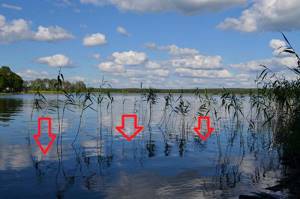
Finding a fishing spot
Promising places for catching crucian carp with a float in the spring:
- Coastal reeds, reeds, cattail thickets. Crucian carp may not yet be caught with a fishing rod in the reeds in early spring, since it simply isn’t there. In the southern regions, with the melting of ice in many reservoirs, silver is already in the thickets. However, the activation of the bite is still far away; you can catch it with small animal baits on thin, neat rigs.
- Vast shallow bays with sparse reeds and mud at the bottom.
- According to the running of crucian carp - the entire course of the small rivers along which it travels. In the spring, it is better to choose quiet areas, the border of thickets and quiet water, uniform watering with an average depth, places with return flow, bays and backwaters with reeds, bushes flooded with floods and grassy areas. A good place during the receding flood in the spring is a flooded meadow with young small grass up to 1 meter deep, from which the water gradually drains.
- In ponds and lakes there are uniform warm areas with depths of up to 1.5 meters. As long as it’s not pure sand or clay, there should be unevenness at the bottom, or better yet, some kind of vegetation or silt.
- In any reservoir there is a border between clean water and thickets.
- Closer to summer - deeper water areas, snags, shore edges, sprouting water lilies. I’m starting to work my usual summer places.
- Clearings and windows among continuous massifs of aquatic vegetation.
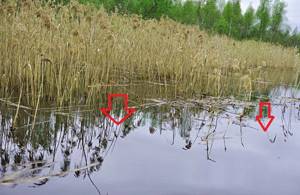
Float tackle
There is only one requirement for equipment for crucian carp on a fishing rod in the spring - in March and April, for passive biting, we use the lightest and most sensitive equipment on a fishing line of 0.12-0.16 mm, then more reliable ones, especially in reeds, with thicker leaders 0.16-0.2 mm and large hooks , 12-10 numbers.
You can fish with a regular fly rod, a rod with a small inertial reel, or gear for long-distance casting - with inertia-free (Bologna gear) or heavy equipment with a float of more than 3 grams of carrying capacity with sliding equipment (match type).
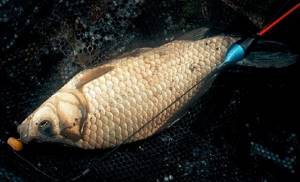
Fly fishing rod
In a fly rod, the main line is attached to the tip of the rod with a connector. The length of the rig is about half a meter longer than the rod, for ease of casting. This is how we rigged our bamboo and walnut fishing rods when we were kids. Now the development of this direction is a modern fly rod.
Typically, anglers use rods 4-6 meters long. Modern carbon fishing rods are lightweight and easy to use even at this length. The meaning of the gear is that casting can be done no further than 80% of the length of the fishing rod + equipment. The greater the depth, the closer the float is to the tip.
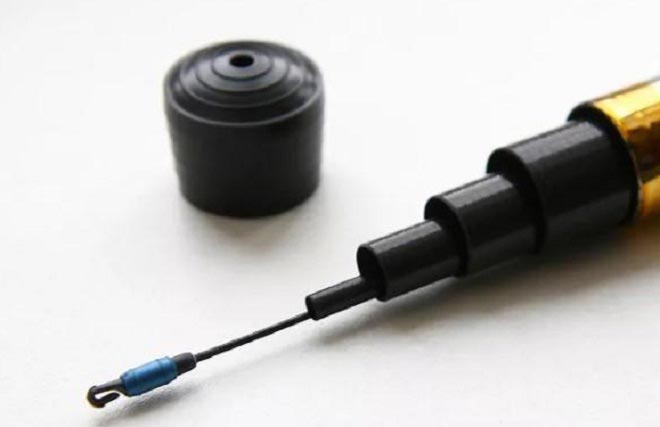
But such tackle is the lightest and most convenient to use. For fishing in reed windows, coastal thickets and in shallow water from a boat or wading, this length is sufficient. You can make the lightest possible rigs with floats weighing 1-2 grams.
The classic equipment of a float rod for crucian carp in the spring is a blind float, pellets for loading and feeding at the bottom 7-10 cm from the hook. The tackle is installed so that the hook lies on the bottom. When biting, the float usually rises or even lies on the water, and with a pull it sinks or moves to the side.
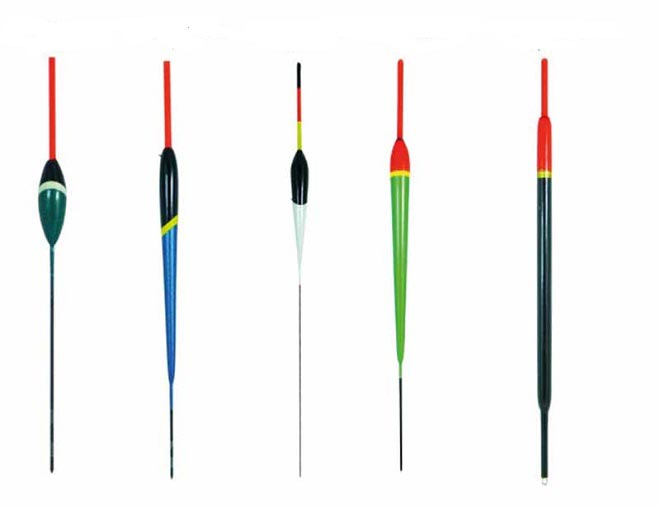
Floats for blind equipment
In general, this is the most common and simple fishing rod. The option with a small inertial coil works also. The reel is used simply for the convenience of storing the fishing line in a wound state and transporting it. With a regular fishing rod you can fish hard-to-reach places - windows in the reeds, clearings where you can’t really use a donkey or a feeder. And these are the most promising places during the crucian season in the spring.
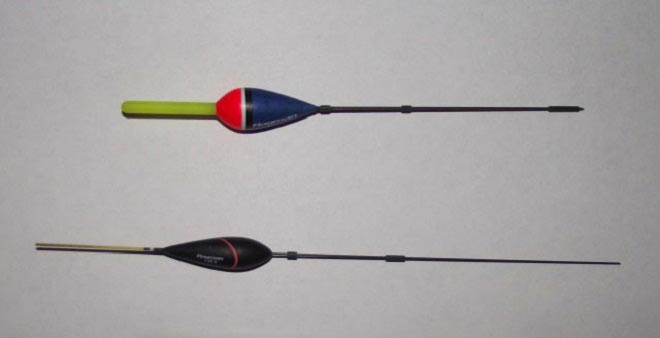
Floats for delicate fishing
In windy conditions, the float can be overloaded so that the body is completely submerged in the water, and the tip of the antenna sticks out on the surface. When bitten, the float will rise higher and sink. To do this, we install a heavier feeder or pellet
To load a gram float, generally only one correctly selected pellet in the equipment is enough. Such a lightweight rod rig registers the most accurate bites. However, you can’t exactly throw it into the wind, but it blows away in the current.
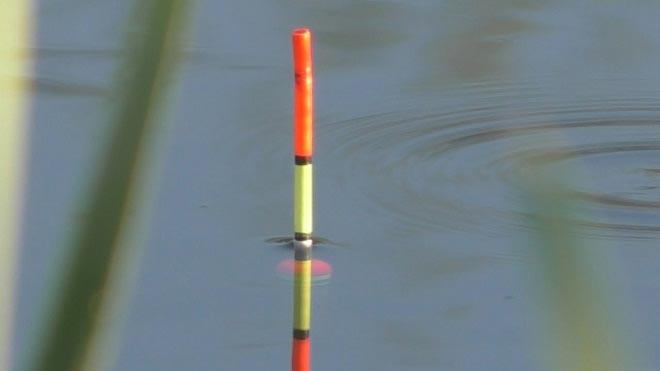
Any float will do, depending on what you want - from a goose feather to modern foam or balsa structures. For windows on long fishing rods, it is better to use a sliding rig - in this case the depth is adjusted with a stopper above the float. It is easier to accurately cast a sliding fishing rod into a compact reed window or clearing. On heavy equipment, instead of one large pellet, it is better to place several small pellets and distribute them throughout the forest from top to bottom from large to small.
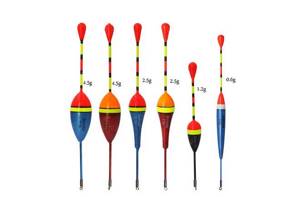
Large floats for fishing in zhor
An active crucian carp will also drag away a 5-gram float with a heavy weight. For passive fish, it is better to make sensitive equipment, selecting weights according to the principle of compensating the weight of the load with a pop-up float.
Read more about rigging a fishing rod with a float for crucian carp
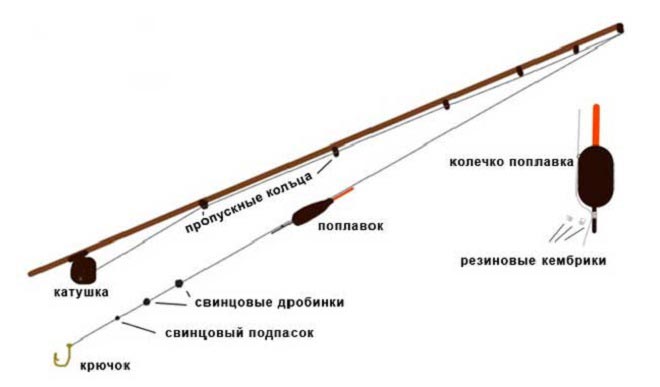
Scheme of blind equipment
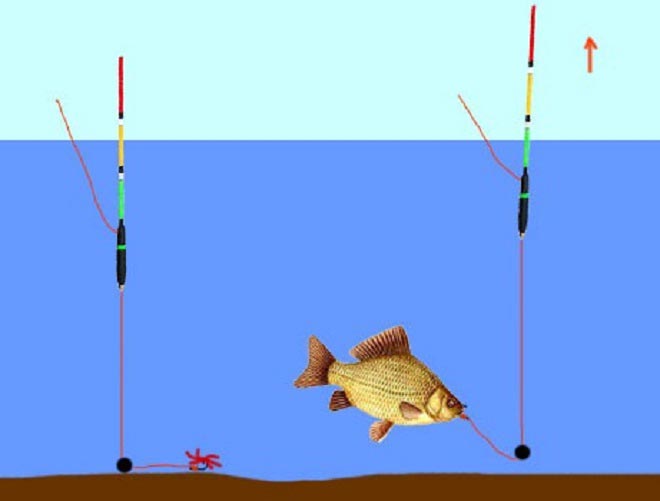
Long cast
Quite often, when catching crucian carp on a float in the spring, a longer cast is required. In early spring, sometimes it is necessary to reach a hole located 10, 20 or more meters from the shore. It is impossible to fish in such conditions with a dead rod.
Only a donka or a fishing rod for long casting. By equipping a telescopic rod with rings with a light spinning reel (at least a Chinese one for 150 rubles), we get Bolognese tackle. But in our country, this gadget is often called simply “a fishing rod and reel.”
Article – a fishing rod for long casting.
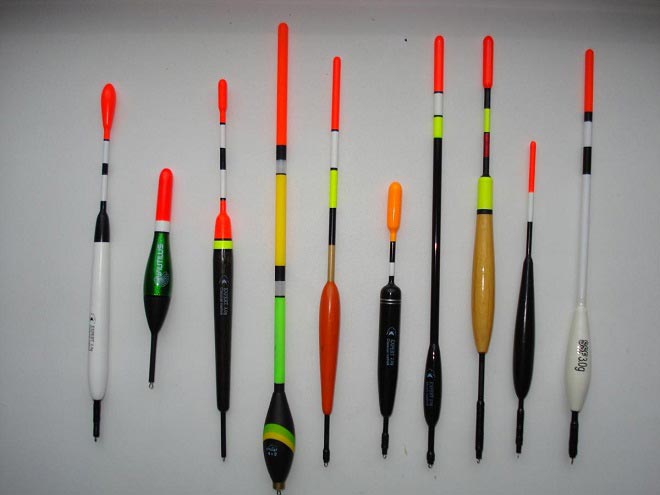
Floats for sliding equipment
With a larger float, 3-5 grams, such a fishing rod can be cast 10-20 meters. When fishing in shallow water, you can use blind equipment, as in a fly rod, but in depth it is better to use sliding floats. The rubber stopper will not work in this case - it does not fit into the rings.
However, if the depths do not exceed the working descent of the float rod for casting, a silicone stopper is also suitable. At depths greater than 4 meters, the stopper must be knitted from fishing line or thread. Article about sliding float equipment for crucian carp
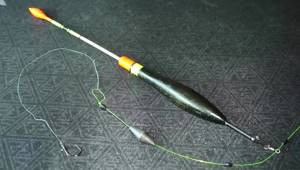
Sliding rig for crucian carp
Match fishing rod
For fishing at distances over 20 meters at any depth, match gear is more suitable. Our fishermen are familiar with it - it is essentially a fishing rod with a good reel of 1000-2000 spool size and a heavy float of 5 grams with a large bright antenna visible from afar (or a high striped end that sticks out above the water, and the bite is visible by changing stripes, the body of the float while underwater).
In a simple version, you can use a regular telescopic fishing rod or spinning rod as a casting rod. A real match rod is similar to a feeder - a plug-in carbon fiber with high-quality rings and a 3-4 meter long cork handle. Of course, with a real match fishing rod you can cast lighter rigs over long distances.
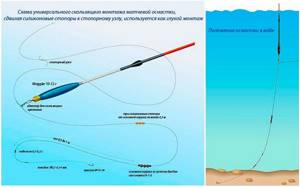
Match equipment
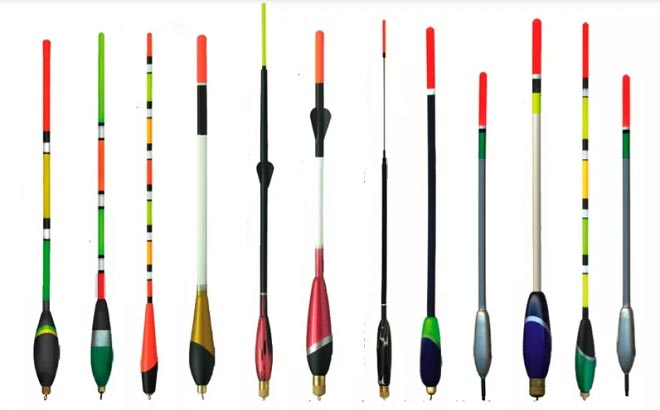
Wagglers and sliders - floats for match fishing rods
The main difference between a matcha and a regular fishing rod is in the equipment. For the match, special long floats with large antennas and a short keel (or without it at all) are used - wagglers, sliders. Such floats have excellent aerodynamics and fly far. The equipment is sliding, including a running sinker, limited by stops.
On simple folk gear for a hybrid or carp, such long-range equipment is mounted on a main line of about 25-0.28. In the correct match gear, thinner fishing lines can be used - 0.16, 0.18 mm. This allows you to hold lighter rigs in the current. Read more about rigging a match fishing rod.
Half-bottom
In the current, you sometimes have to catch river crucian carp in a fairly strong current. To do this, it is convenient to make a half-bottom tackle from a fishing rod based on match or similar tackle for long casting with a sliding float and stopper. Such a fishing rod is loaded with a sliding sinker of large mass - 10 grams or more, which will sink the float.
Naturally, for the fishing point you need to set the depth with the upper stopper so that the float sticks out above the water. When biting, the fishing line is pulled through the running sinker by the fish, and the float is recessed. A fishing rod with a feeder also works on a similar principle, but instead of a weight, a small spring with a weight is placed. It turns out to be a kind of mini-feeder with a float.
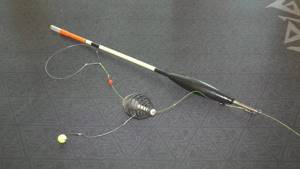
Half-bottom with feeder
There are many varieties of fishing rods for crucian carp. In the spring, you need to use what suits the fishing conditions, as well as based on personal preferences. There is no best gear option - there are ones suitable for specific fishing conditions.
Summer nod
Another working way of catching crucian carp in the spring with a fishing rod is with a jig on a side nod. At times, the crucian carp does not take a stationary bait at all, but reacts to a playing jig. For jigs, light rods with rings and a small reel, no longer than 4 meters, are usually used. Longer jigs are inconvenient to play with. From a boat you can fish with short ones of 2-3 meters or even with winter fishing rods from the side. An article about catching crucian carp with a nod in the spring.
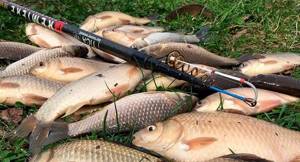
Lure
In addition to the right location and equipment, the feeding system is, of course, very important in the tactics of crucian carp. In early spring, one bait is required, and after the bite becomes active, another is required. During the feeding season, you can catch crucian carp in the spring using a float rod without bait. However, most often feeding is still needed, especially closer to summer, when the bite gradually settles down.
At the beginning of spring we use poor, fine mixtures, with a weak natural aroma, dark in color - like in winter. In April-May, porridges begin to work - the mixture is made on the basis of a dry base, store-bought or homemade, with the addition of boiled millet, pearl barley or peas. It would be useful to add chopped worms to the bait due to the active bite of crucian carp.
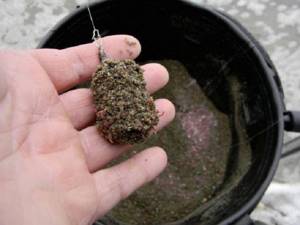
Fine grinding for early spring without feed particles (feeder)
If it is possible to constantly visit a body of water, but the place is unknown to anyone else, it makes sense to use bait. To do this, you can pour 2-5 kilograms of boiled millet, corn, wheat, pearl barley with cake and breadcrumbs onto the point every 2-3 days. In warm water, bait for crucian carp in the spring on a fishing rod is always needed - we experiment with compositions and aromatics.
Read more about feeding crucian carp
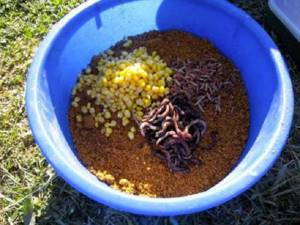
Feed fraction
Finding fish in a pond
After water bodies are cleared of ice, crucian carp leave their wintering grounds and begin to actively feed. It is attracted to places with well-heated water and plenty of food. At the beginning of spring, it is found in shallow coastal areas with a depth of 20-100 cm. In the second half of spring, when the water temperature rises, the fish begins to move to depth, moving further and further from the shore.
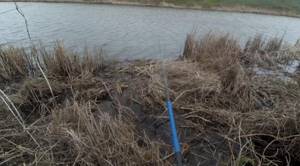
The main places for catching crucian carp in the spring:
• the tops of the edges, located next to the gently sloping shore; • areas of shallow water in the coastal zone, abundantly overgrown with grass and reeds, which are flooded during the spring flood; • thickets of algae and reeds up to 1-1.5 meters deep; • hills and shallow snags where crucian carp can easily find shelter in case of danger.
Typically, active biting of crucian carp is observed until mid-May. After this, it begins to spawn, and the bite practically stops - only small crucian carp are caught.
Baits and lures
Traditionally, the best baits for crucian carp on a fishing rod are a dung worm and corn. Moreover, in early spring, a worm works better, as well as other animal baits - maggots, bloodworms, bark beetle larvae, lard, dog or cat food. The worm also works on crucian carp in warm water - it’s just that most often in late spring or summer such bait does not allow the silver fish to wait.
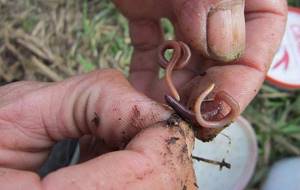
Vegetable baits in the spring for crucian carp on a fishing rod work better in May, with warming. In addition to experimenting with baits, you also need to select aromatics. Often crucian carp like to peck at strange aromas - kerosene, star ointment, valerian or WD-40. Every self-respecting crucian fisherman should always have the usual additives, garlic and anise, with him when fishing.

It can be difficult to determine what to use for catching crucian carp in the spring on a fishing rod in an unfamiliar body of water - and the absence of bites does not mean that there are no crucian carp or there will be no bite. We begin to purposefully try the entire arsenal of available baits in their pure form, using different bait methods and in sandwiches. Then we try each of the options with garlic, anise, vedeshka, etc. Most often in the spring you still manage to pick up the keys to the fish. Moreover, after this you can catch more in an hour than in a whole day and go fishing.
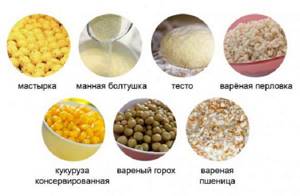
In May, any grains, mash, mastyrki, bread crumbs with halva also work. If small roach are tormented, we fish with harder and more inaccessible baits - peas, corn, a few grains of undercooked pearl barley. Fishing for crucian carp in the spring is a constant experiment and search for nuances on which the success of fishing directly depends.
Subscribe to the channel:
YouTube channel RYBAFAN
We are VKontakte
Bait for catching crucian carp in spring
Omnivorous crucian carp in spring prefers high-calorie foods rich in proteins. The most catchy are considered:
- red worm;
- maggot;
- bloodworm;
- caddisfly
In the second half of spring, fish willingly take plant foods:
- dough;
- steamed pearl barley;
- semolina and mash from it.
When preparing the dough, it is better to take pea or corn flour, as well as semolina and mix with egg yolk. For scent, you can add a drop of sunflower oil.
